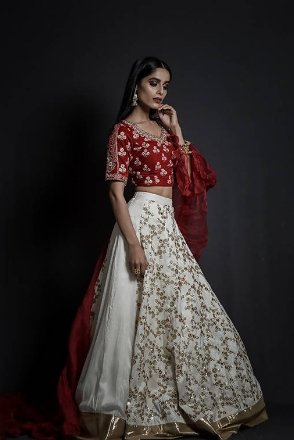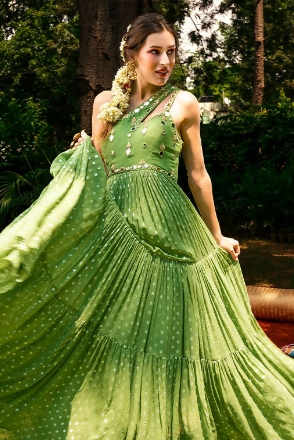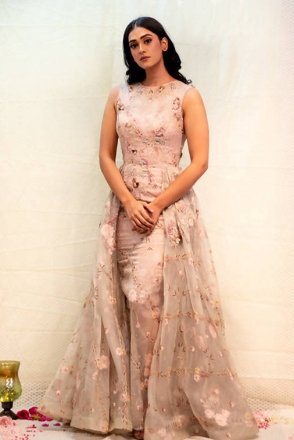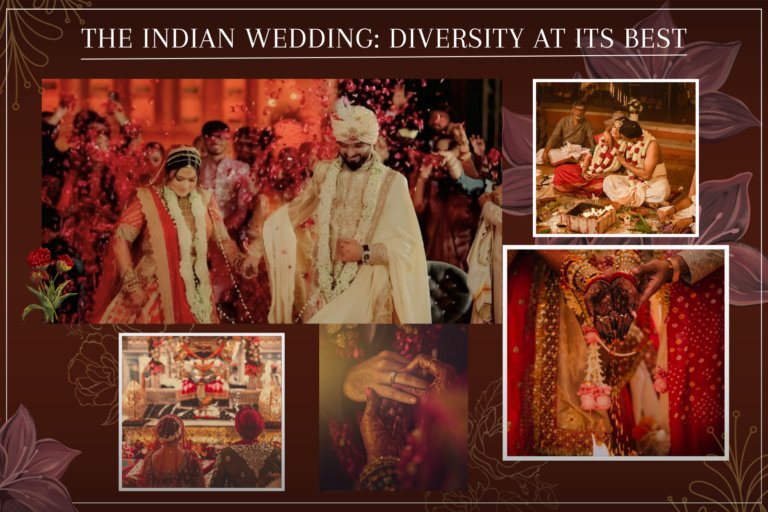By Deepali Nandwani
RAHUL Mishra is certainly not your prototypical fashion designer. His inspirations are multifarious; they often lie in the heartland of India, rather than in its metro cities. He began his career from a sleepy village of Malhausi, deep within Uttar Pradesh, and rose, through sheer dint of genius and hard work, to showcase his eclectic fashion and his offbeat design sensibilities in fashion capitals such as London, Paris and Milan.
Mishra, who debuted at the Lakme Fashion Week in 2006 and won the Woolmark Prize in 2014, the first Indian to do so on the strength of his delicate embroideries, has championed the cause of slow fashion, drawing from his roots and using traditional Indian textiles and handmade couture. He mines the country’s textile traditions in a bid to preserve the weaving and embroidery techniques and adds details such as his trademark scallop finishing on dupattas, which is quite popular with brides and the lovers of couture.
Mishra represents the metamorphosis of Indian couture over the last few years. His collection has, over the years, showcased jamdani kurtas, crisp angrakhas and bandis with the lightness of touch. His 2019 collection draws inspiration from two very different worlds–a recent trip to Monaco, the mecca of luxury, and childhood memories of his rustic home in Uttar Pradesh. “The collection celebrates the connection between a home where one is born and a home that one finds during their self-granting escapades of travel; it is a celebration of the beauty of nature. A dense play of florals and architectural elements has been blended in a subdued form. Two- and three-dimensional hand-embroidered surfaces have been created with Swarovski crystals and silken threads to imitate the lush greenery of rich forests and lakes,” he says. Comfort is the key here; comfort and making a statement. The fabrics are lighter – more of sheer organza, georgette and crepe.
Mishra’s designs narrate the story of how Indian couture in general and bridal fashion in particular, has evolved. It’s lighter, much lighter than the odd-30 kilos it weighed till about three years ago. Intricate embroidery and zardozi still hold fort; there is all that glitter and shimmer. But there is also craftsmanship and experimentation with silhouettes, structure and colours, and there is a hint of understatement. If a few years ago wearing black would be considered sacrilege, now black is part of the colour pantheon that brides include in their trousseau.
What began as a rebellion four years ago when a few designers sent out beautiful black couture pieces on-ramp is today a deluge. The garments are not just lighter but also more fluid, or the other extreme, very structured. The heavy drapes have given way to half-saris worn more like long dupattas tucked into the waist and draped over one shoulder, teamed with a churidaar and an elaborately embroidered choli.
Monotone has faded out, only to be replaced by a vibrant burst of colours. Dusty tones in light pink, lavender, pastel yellow, tea green, light blue along with traditional Indian colours like shocking pink, reds, maroons, Indian greens, rust, mustards, gold beige, emerald, peacock are being complemented by nude, ivory, champagne and dull gold. They may not have yet upstaged the party, but they are elbowing their way in.
…..
Even as we celebrate the discrete melding of traditions and modernity, what we cannot overlook is how couture in India has been inspired by the revival of traditional textiles, embroideries and handlooms. And a part of the larger revival movement in the Indian textile industry has been led by Ritu Kumar, who in her earlier part of her career, worked with traditional hand-blocking techniques from Bengal to establish the early forms of ‘ethnic chic’ and opened her first boutique in Delhi, in 1966. In 1973, she showcased zardozi embroidery, which had its origins in the royal costumes worn by the Mughals. Over the years, she experimented with ancient Indian techniques in weaving, printing, dyeing and embroidery, and revived several lost-to-time embroideries such as ikat, patola, bandhani and shisha or mirror embroidery.
It was Rohit Khosla (1958–1994) who pioneered the fashion industry and co-founded Ensemble in 1987 with Tarun Tahiliani and Abu-Sandeep. While Ensemble offered space to several up and coming designers who went on to become a force to reckon with, Abu Jani and Sandeep Khosla dug deeper into the legacy of Mughal royal costumes and revived chikanakari, besides introducing floor-length Anarkali-style of churidaar-kurtas in 1988.
India’s rich heritage of craftsmanship and artisanal excellence permeates our haute couture even today. “Couture is a canvas for handcrafted Indian traditions such as zardozi, fareesha, aari and resham, which we have inherited as part of our legacy,” designer Tarun Tahiliani once told me. The designer is famous for mining India’s luxury and couture traditions. Way back in 2014, at the India Bridal Fashion Week, he unveiled The Modern Mughals. The Mughal motifs— paisley, gota and resham embroidery and the minaret motif—found their way across the collection—a range of exquisite lehengas, saris, anarkalis and long jackets for brides. That was also the time he put out couture in black. “I love black. It’s timeless and can be used in other wedding functions if not the main event,” he said. He showed elaborately layered lehengas embroidered with gota and resham or embellished with tiny mirrors and Swarovski crystals, saris with hints of delicate flowers or classic zari work, and anarkalis coupled with flouncy skirts or harem-balloon salwars.
His colour palette stretched to include a fiery red, light pink, beautiful jade, mauve, gold, bronze, white and shades of yellow and orange. Tahiliani has modernised drapes with his trademark structured draping. “It’s unfortunate that despite a long tradition, we have forgotten how to drape, which is why structured draping helps.”
Embroideries have always been his forte and for his spectacular couture, bridal or otherwise, he has experimented with chikankari, mokaish, resham, gota and 3D made to look like Burmese mirror work. To add drama to his couture, Tahiliani layers his clothes. Humungous amount of research about embroideries, textile traditions and drapes form the bedrock of Tahiliani’s couture. “In some of my collections, I have used antique Jamawar, printed and then embellished with mirror work. That requires knowing the textile, the embroidery and the traditions rather well,” he has said. Textiles such as Kanjeevaram and Maheshwari are now part of mainstream Indian couture. Tahiliani’s 2019 couture collection ‘Bloom’ spans heavily-embellished garments in shades of beiges and nudes to reds and oranges. There are classic pieces, tone-on-tone lehengas, anarkalis and saris that make a statement.
India’s couture has been dominated by designers who were considered the genius of their times. Rohit Bal revived and introduced several classic silhouettes such as free-flowing anarkalis and lehengas in vintage colours such as ivory and indigo blue, in sumptuous velvet and silk fabrics. Bal has often sent out his models dressed in long jackets, capes and voluminous lehengas, embossed with floral embroideries and in flaming prints. Manish Arora introduced Indian kitsch to both, the snobbish world of haute couture and the Indian wedding trousseau, while Monisha Jaisingh shortened the traditional kurta to develop the kurti or the Indian tunic.
The modern touch
Couture has to have a sense of modernity even as it keeps us anchored to our past. Tahiliani’s ‘Bloom’ is a collection that encapsulates, as the statement puts it, “the metamorphosis of the Indian bride with a synthesis of different cultures. When we started, we came out of a textile tradition,” he says, deconstructing the various aspects that set the vast repertoire of Indian textiles apart, from the use of colour and intricate embroidery techniques to the region-specific drapes of the garments. The collection brings each of these elements together with contemporary design interventions such as digitally printed patterns, Swarovski crystals (a leitmotif in Tahiliani’s designs) and a sense of lightness.
Much like contemporary India, Indian fashion melds antiquated traditions and modernity, a sense of spirituality and a love for a sybaritic lifestyle. Designers, such as Tahiliani create what he calls ‘India Modern’ Couture. “It is easy to lose your roots and heritage if you focus too much on the contemporary. A harmonious marriage of the two is of utmost importance, more so ever today,” he says.
Another ‘India Modern’ couture designer, Gaurav Gupta’s structured and tailored saris or sari-gowns are new-fangled, modish, do away with cumbersome drapes and pleats, and yet, are a nod to the timeless drape. Gupta’s silhouettes are dramatic and sensual. Think sheer panels, peek-a-boo cutouts and unforgiving fits, along with full-skirted lehengas and long brocade jackets. In his 2019 collection, he has teamed his signature sari-gown with embellished capes.
Our love for the quintessentially classic silhouette has ensured that designers innovate constantly. Recently Anamika Khanna paired the six yards in indigenous weaves with a boho jacket and sharara pants, a look flaunted by actor Sonam Kapoor at her 2019 Diwali party. It was Kapoor, a style icon to many, who also styled an ivory Sabyasachi sari with a cropped jacket blouse.
Designers Shyamal & Bhumika reinterpreted the traditional lehenga with Chantilly lace and paired it with bikini-style blouses and simple dupattas. Their 2019 couture collection is inspired by the iconic period of Renaissance, where art, architecture, music, couture and theatre were reborn from the medieval ages and brought to modernity. “It features intricate embellishments and surface ornamentations with elaborate beading, silk thread embroidery and floral motifs in gold zardozi thread,” says designer Shyamal Shodhan.
Designer Amit Aggarwal is credited with bringing technology into the world of Indian couture with his collection ‘Lumen’, inspired by a virtual reality experience the designer had at London’s Saatchi Gallery. The exhibition focused on how the architecture of both plant and human anatomies is connected by breath. “Layering has been a huge part of this collection and it is one of the key techniques that we haven’t experimented with before. We’ve tried to create an illusion of colours through shadow play and layers,” says the designer, who used jewel tones and neutral shades, with an eclectic mix of neon colours for the collection.
The Bollywoodisation of couture
Bollywood is never far behind when it comes to fashion. In the past few years, Hindi movie actors have taken over the ramps from the supermodels of the yore and every designer worth their money, and their label, use glamorous actors as a model for their couture.
One of Indian fashion industry’s biggest designer, Manish Malhotra, has roots deep in Bollywood. His collections pay tribute to the glamour and glitz of the film industry; it is pure unabashed glamour but with a vintage spin. His clothes feature mirror work, zardozi, sequins and resham embroidery on lehengas and saris, paired with jacket-style blouses and restrained floor-length kurtas. While the voluminous, hand-embroidered lehenga is his signature silhouette, upended couture wear and bridal fashion are transforming, he says. Gowns and heavily embroidered cocktail dresses have made their way into Indian couture and wedding trousseaus.
Bollywood’s larger-than-life influence on Indian fashion is obvious from the reams of press that the weddings of two of its biggest divas – Deepika Padukone and Anushka Sharma received, and not just because the fact that they are leading actors, or that the former married an equally successful male star, while the latter wedded the Indian cricket team’s captain, Virat Kohli, but also because of the couture. Both claimed to have been dressed by one of India’s biggest designer, Sabyasachi Mukherjee. Padukone’s wedding courted controversy when it came to light that the bride’s wedding saris were bought from Bangalore-based heritage label, Angadi Galleria, by her mother, a fact Mukherjee acknowledged in a post. Sharma’s dreamy pink wedding lehenga has spawned several clones.
Yet, being a “Sabyasachi bride” is almost every Indian woman’s dream. The fact that the Kolkata-based designer has also designed the wedding trousseau of every big Bollywood actress who has chosen to get married in the last few years, adds to his mystique as a designer. Sabyasachi channels a vintage vibe through the clothes he designs – the long-sleeved blouses and lush silk saris worn by the zamindar’s wife in Bengal of the 18th and early 19th century, and the sensual velvet and silk garments of the Mughals or the Rajasthani royalty. His ‘Ferozabad’ collection was infused with a Maharani-chic vibe. The Autumn-Winter 2019 collection, ‘Charbagh’ spans four different branches–Devi, Nargis, Chowk and Isfahan, each one conveying a different tone and sensibility.
If Devi is dominated by the quintessential red lehenga, Nargis (the word means flower in Persian) has floral motifs embroidered in colours such as turquoise, yellow and pastels. If Chowk is an ode to the Indian heritage of embroidery and colour-blocking, Isfahan is a collection in sumptuous velvets and silks. Mukherjee says: “Whether it’s embroidery or weaving, hand-block printing or dyeing, I like clothes made by hands because when you create something out of human hands, it’s never perfect in the sense that imperfections give it personality. In today’s day and age, when the world gets more and more mechanised, it’s the things that you do by hand that are becoming luxurious.”
The sari as the ultimate sartorial garment
The past few years have seen the revival of the sari as an haute couture garment and the rise of designers such as Sanjay Garg (Raw Mango) and Anavila. The unstitched six-yard wonder now holds its own against the lehengas, the kurtas and the cocktail gowns. The sari has truly transcended the ages to become every designer’s muse and modern Indian woman’s haute couture staple. While tone-on-tone embroideries, unusual colours and sheer fabrics set the mood for a cocktail evening, the quintessential staple of every wedding, the sari, is being revitalised. Structured sari-gowns, lehenga saris, dhoti saris with cut-work in vibrant hues with a fusion of Indian, Mughal and European influences, bold blouses with razorbacks, sheer necks, corseted bustline ensure that the woman looks edgy.
The other sari evangelist is Anavila Misra who established her label, Anavila, in 2012 and uses linens to weave her saris. Over the years she has worked with craft clusters in Bhuj and other parts of Gujarat and Bengal to modernise the weave. “Since the very inception of the brand, we have been working on creating a modern language in saris using linen. Starting with the very basic plain weave, we have worked on different textures in linen itself, blended a variety of yarns with linen, created blocks and experimented with hand block printing on linen textile. The blend of zari and linen has also created a beautiful luxury textile.”
Mishra has even used linen to create festive and bridal couture collections. “Our festive wear is usually something very heavy and over-embellished, and uncomfortable. With this collection, we wanted something super wearable, comfortable, understated, yet elegant enough to be worn for an occasion,” Misra has said. She interplays 80% linen with silk to create luxurious drapes.
The House of Angadi, brought into sharp focus after the Deepika Padukone wedding controversy involving their saris, is a label that has emerged at the forefront of the “sari as a couture garment” movement. K Radharaman, the founder, CEO and design head of the House of Angadi, says his label ADVAYA is a contemporary rendition of traditional textiles, dyeing techniques such as Ikat and weaves, and India’s living unstitched garment heritage. He inherited the legacy business form his father, R Kothandaraman.
At the House, Radharaman mixes innovation and exemplary craftsmanship to create a new prototype for luxury handloom businesses in India. “For the western market, we began to play with the basic construction of the textile, which led me to also establish Advaya. I began exploring ways in which the traditional Kanjeevaram could be blended with linen and khadi instead of the traditional silk-by-silk composition. The idea was to fuse a weave as opulent and sumptuous as Kanjeevaram with a modern and minimal linen and khadi. It is a misconception to claim that Kanjeevaram is a weave. It, instead, refers to the Kanchipuram cluster of weavers and includes motifs, technique, colour and construction.”
Labels such as Raw Mango, Anavila and ADVAYA and to an extent designers such as Sabyasachi Mukherjee, Tarun Tahiliani and Gaurav Gupta have added their heft to promote saris by elevating heritage Banarasis and Kanjeevarams to couture level.







